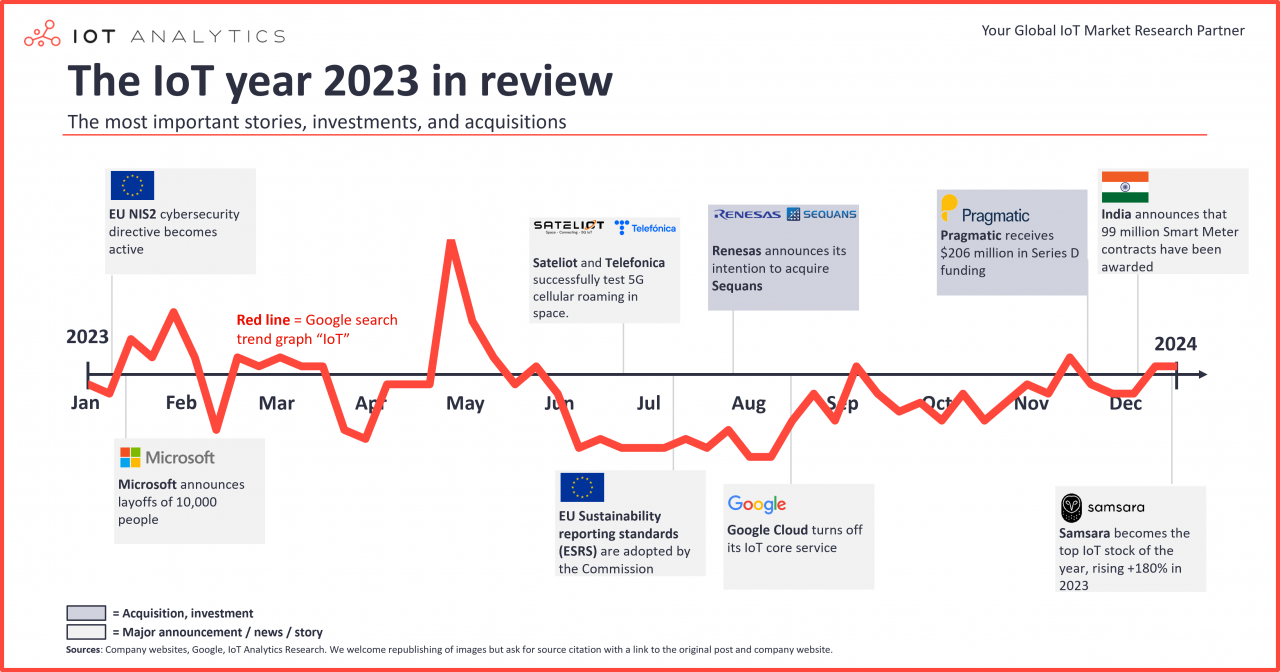IoT 2023 in review: The 10 most relevant IoT developments of the year

In 2023, the global economy saw unexpected outcomes, with many regions, particularly the U.S. and Western countries, showing resilience in the face of challenges like high interest rates and inflation. This unexpected strength prevented the recession that many had anticipated. The global GDP grew by 3.0%, surpassing early expectations, though it still fell short of the historic average by 0.8 percentage points. While the tech market saw strong performance, with indices like the Nasdaq Composite rising by 43%, the Internet of Things (IoT) market also showed steady growth, with IoT devices reaching approximately 16.7 billion by the end of the year. The global enterprise spending on IoT was about $235 billion, reflecting its ongoing significance despite the rise of new technologies like generative AI.
Despite the spotlight on AI, the importance of IoT remains undiminished. Many organizations continued to scale their IoT operations, managing millions of connected devices. For example, Nestlé announced 2.8 million connected devices by the end of 2023. While the term "IoT" has seen a slight decline in corporate discussions, this does not reflect a waning importance; rather, IoT is quietly expanding and scaling in many industries. The shift in corporate focus towards AI may overshadow IoT in terms of buzzword status, but in practice, IoT is becoming increasingly integral to businesses' operations.
2023 also saw significant regulatory developments affecting IoT. A notable change was the European Union's NIS2 cybersecurity directive, which came into force in January 2023. This directive aims to address cybersecurity risks by setting requirements for risk management and incident reporting across various sectors, including digital infrastructure, which is critical for IoT. Companies are required to comply by October 2024, with penalties for non-compliance potentially reaching up to €10 million or 2% of global annual revenue. This regulation is expected to have a substantial impact on the IoT sector, especially as companies become more dependent on digital infrastructure for their operations.
Another significant event in 2023 was the wave of tech layoffs, which affected companies deeply involved in IoT and AI. Microsoft, Google, and Amazon all announced significant layoffs, with a notable portion of IoT-focused personnel being impacted. These layoffs, particularly in the IoT sector, led to increased uncertainty about the future of tech jobs, particularly in the startup ecosystem. Despite these setbacks, companies like Renesas continued to expand their IoT portfolios through acquisitions, such as its purchase of Sequans Communications, a cellular IoT chipmaker, for $249 million. This acquisition is part of Renesas' broader strategy to strengthen its position in the IoT market.
The year also saw advancements in IoT connectivity, particularly with the success of 5G in space. A collaboration between Sateliot and Telefónica demonstrated the first successful test of a roaming 5G cellular network in low-Earth orbit satellites, providing connectivity for IoT devices even in remote or rural areas. This breakthrough is expected to open up new possibilities for industries that rely on consistent connectivity, such as agriculture, logistics, and transportation. Alongside these technological strides, sustainability and environmental, social, and governance (ESG) concerns played a larger role in IoT initiatives, with new regulations like the Corporate Sustainability Reporting Directive in the EU making it mandatory for companies to report on their environmental impact, including data related to IoT.
Source: https://iot-analytics.com/iot-2023-in-review/